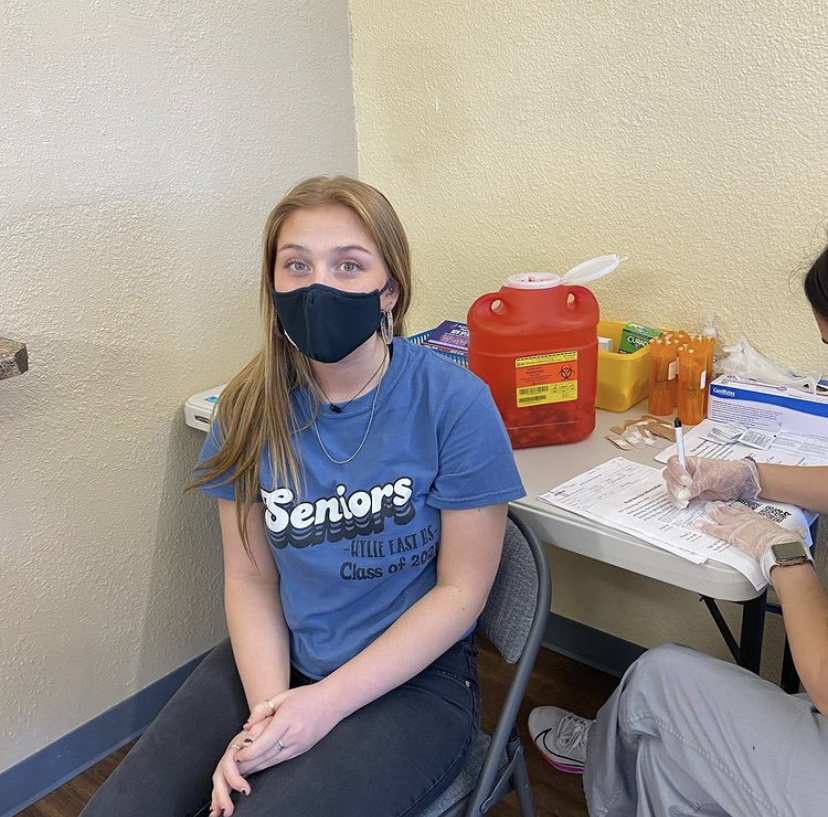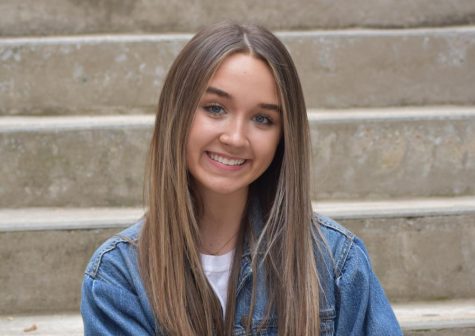Teens with vaccines
Students join widening range of people receiving COVID-19 vaccinations
photo credit: courtesy photo
Calling the shots \\ Senior Jada Hahs prepares for her first shot during her first round of vaccinations. “It didn’t hurt at all actually,” Hahs said. “I told myself to expect the pain of a piercing, but I hardly even felt it.”
March 30, 2021
The world has come a long way since spring break of 2020. After over a year of masks, social distancing, remote learning and quarantine, things have finally started looking more promising and the home stretch to normalcy seems to have finally begun. A part of this shift comes from the widespread distribution of various versions of the COVID-19 vaccine. These vaccinations were originally only available to adults in the high-risk category, or essential workers. However, the range of those receiving them is growing exponentially, and is now beginning to include students.
Juniors Ryah Hill and Grace Duck, as well as senior Jada Hahs were among those to receive their first round of vaccinations this month, and will receive their second and final round in April.
“I wanted to get the vaccine to not only continue to protect myself, but also to ensure that my friends and family around me were safe as well,” Hill said. “I also have a health issue that would be concerning for my family if any of us were to contract the virus again, so we all decided as a family to get the vaccine.”
While there are various reasons for students getting the vaccine, health risks within the family are one of the primary motivations for young students opting to get vaccinated as soon as possible.
“I have hypertension and with the mask mandate being lifted, I decided it was the best thing to keep myself safe,” Duck said.
Despite health concerns being a commonly shared motivation, other students are choosing to get vaccinated as a step towards normalcy, and to return to their lives as they were before the effects of COVID-19.
“I wanted to get it so I could feel a little more free to do the things I used to,” Hahs said. “I also wanted to so that I can eventually travel to see my grandparents that I haven’t seen in over a year.”
The three vaccinations currently approved for public distribution are Pfizer, Moderna, as well as Johnson & Johnson. While all three aim for the same results, their side effects vary as well as the reported effectiveness. However, currently the Pfizer vaccination is the only one available to those ages 16 and up, with Moderna and J&J being restricted to those 18 and up for the time being. The reason for this being that both the J&J and Moderna vaccinations conducted their pharmaceutical trials on people of ages 18 or older, while Pfizer conducted trials on people of ages as young as 12.
“I received the Pfizer vaccine mainly because it was the one available to me,” Hill said. “However, it didn’t bother me because it’s known to be the most effective.”
These new vaccinations have been backed by various forms of scientific trials and medical research within the past year. Therefore, while some students feel the existing research is reliable, others have been more hesitant to immediately jump on board.
“I was not worried at all,” Hill said. “I was more optimistic and excited to be vaccinated because I knew and trusted the health experts that prepared the vaccinations for the public.”
While the long-term effects can only be hypothesized at the time, a large source of public concern stems from the vaccine’s immediate side-effects, such as fever, nausea and soreness.
“Personally, I was worried,” Hahs said. “Just because I’ve heard it can hurt a lot and the side effects can be really bad.”
The vaccine itself has often been reported to cause muscle soreness in the arm where it is injected. Yet, the extent of this pain varies from person-to-person, as many of the side effects do.
“The shot didn’t hurt for me at all, it felt as easy as the flu shot,” Hill said. “However, I’m not afraid of needles so I wasn’t expecting much.”
Other immediate side effects vary, with the majority reporting fatigue, headache, and nausea as common symptoms.
“It made me tired about 30 minutes after so I took a nap when I got home,” Duck said. “The morning after I felt a little nauseous and my arm was sore but that’s it. Nothing too serious for my first round.”
Unlike the single-dosage Johnson & Johnson vaccine, both the Pfizer and Moderna vaccinations come in two separate rounds, with the recommended interval for the Pfizer vaccination being 21 days, and 28 for Moderna.
“I know my family and friends that have received the vaccine have said side effects are more common with your second dose,” Hill said. “So I’m setting myself to expect more side effects with that round.”
While getting vaccinated is not a guaranteed immunity to COVID-19, students who have received it are able to enjoy a few aspects of their pre-virus lives that they felt unsafe to participate in before their shots.
“I am looking forward to seeing my family who have also been vaccinated,” Hahs said. “Hopefully this is a stepping stone to a more ‘normal’ future for everyone.”
Students and adults alike that are receiving vaccinations are still encouraged to follow safety protocols until further notice, such as masks and avoiding large gatherings.
“Because the virus is still a thing and others are still trying to get the vaccine, we’ve still been maintaining precautions and government protocols,” Hill said. “However, since my extended family is also completely vaccinated, we’ve listened to the CDC guidelines and started having small get-togethers with each other.”
After receiving their first round of shots and awaiting their second, the three students encourage those who are eligible for vaccinations to do so as soon as possible.
“I am very grateful I’ve been able to be vaccinated because I know a lot of people that haven’t been able to,” Duck said. “I encourage everyone who is able to get the vaccine to get it. Definitely look into which one will be the best option for you and remember that you could be saving a life.”




